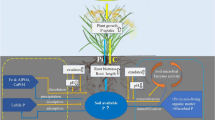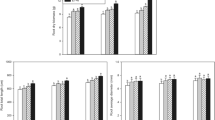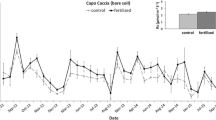Abstract
Background and aims
Elevated CO2 (CE) and temperature (TE) can not only affect crop physiology and growth but also soil nutrient availability, which could in turn influence crop response to CE and TE. However, such indirect impacts of CE and TE on crop productivity are often unexplored, potentially underestimating the impact of CE and TE at a system level.
Methods
To explore the possible role of soil nutrient availability in mediating crop responses to CE and TE, we examined the effects of CE and TE on cotton productivity and soil nutrient availability in two soils.
Results
Early vegetative growth response was dominated by the interaction between CE and TE; TE accelerated vegetative growth while CE enhanced photosynthesis and vegetative growth at ambient temperature. When soil nitrogen availability became low during the reproductive phase, altered soil nitrogen availability at CE and TE and differences in soil characteristics influenced resource allocation and yield response, resulting in a doubling of cotton yield at TE but only a marginal increase at CE.
Conclusions
Changes in soil nutrient availability induced by CE and TE during crop development can enhance or limit yield responses to CE and TE. Thus, soil responses should also be considered when developing adaptation strategy for climate change.





Similar content being viewed by others
References
Ainsworth EA, Long SP (2005) What have we learned from 15 years of free-air CO2 enrichment (FACE)? A meta-analytic review of the responses of photosynthesis, canopy. New Phytol 165:351–371
Asseng S, Ewert F, Martre P, Rotter RP, Lobell DB, Cammarano D, Kimball BA, Ottman MJ, Wall GW, White JW, Reynolds MP, Alderman PD, Prasad PVV, Aggarwal PK, Anothai J, Basso B, Biernath C, Challinor AJ, De Sanctis G, Doltra J, Fereres E, Garcia-Vile M, Gayler S, Hoogenboom G, Hunt LA, Izaurralde RC, Jabloun M, Jones CD, Kersebaum KC, Koehler AK, Muller C, Kumar SN, Nendel C, O’Leary G, Olesen JE, Palosuo T, Priesack E, Rezaei EE, Ruane AC, Semenov MA, Shcherbak I, Stockle C, Stratonovitch P, Streck T, Supit I, Tao F, Thorburn PJ, Waha K, Wang E, Wallach D, Wolf I, Zhao Z, Zhu Y (2015) Rising temperatures reduce global wheat production. Nat Clim Chang 5:143–147
Bai E, Li SL, WH X, Li W, Dai WW, Jiang P (2013) A meta-analysis of experimental warming effects on terrestrial nitrogen pools and dynamics. New Phytol 199:441–451
Baker DN, Baker JT (2010) Cotton source/sink relationships. Physiology of Cotton. Springer, Netherlands, pp. 80–96
Bardgett RD, Freeman C, Ostle NJ (2008) Microbial contributions to climate change through carbon cycle feedbacks. Isme J 2:805–814
Barton L, Schipper LA, Barkle GF, McLeod M, Speir TW, Taylor MD, McGill AC, van Schaik AP, Fitzgerald NB, Pandey SP (2005) Land application of domestic effluent onto four soil types: Plant uptake and nutrient leaching. J Environ Qual 34:635–643
Bloom AJ, Burger M, Kimball BA, Pinter PJ (2014) Nitrate assimilation is inhibited by elevated CO2 in field-grown wheat. Nat Clim Chang 4: 477–480.
Bradow JM, Bauer PJ (2010) Germination and seedling development. In: Stewart JM, Oosterhuis DM, Heitholt JJ, Mauney JR (eds) Physiology of cotton. Springer, New York
Braunack MV (2013) Cotton farming systems in Australia: factors contributing to changed yield and fibre quality. Crop Pasture Sci 64:834–844
Challinor AJ, Watson J, Lobell DB, Howden SM, Smith DR, Chhetri N (2014) A meta-analysis of crop yield under climate change and adaptation. Nat Clim Chang 4:287–291
Conaty WC, Mahan JR, Neilsen JE, Constable GA (2014) Vapour pressure deficit aids the interpretation of cotton canopy temperature response to water deficit. Funct Plant Biol 41:535–546
Cure JD, Acock B (1986) Crop responses to carbon dioxide doubling - a literature survey. Agric For Meteorol 38:127–145
Damour G, Simonneau T, Cochard H, Urban L (2010) An overview of models of stomatal conductance at the leaf level. Plant Cell Environ 33:1419–1438
de Graaff MA, van Groenigen KJ, Six J, Hungate B, van Kessel C (2006) Interactions between plant growth and soil nutrient cycling under elevated CO2: a meta-analysis. Glob Change Biol 12:2077–2091
Dieleman WIJ, Vicca S, Dijkstra FA, Hagedorn F, Hovenden MJ, Larsen KS, Morgan JA, Volder A, Beier C, Dukes JS, King J, Leuzinger S, Linder S, Luo YQ, Oren R, de Angelis P, Tingey D, Hoosbeek MR, Janssens IA (2012) Simple additive effects are rare: a quantitative review of plant biomass and soil process responses to combined manipulations of CO2 and temperature. Glob Change Biol 18:2681–2693
Drake BG, GonzalezMeler MA, Long SP (1997) More efficient plants: a consequence of rising atmospheric CO2? Annu Rev Plant Physiol Plant Mol Biol 48:609–639
Drake JE, Gallet-Budynek A, Hofmockel KS, Bernhardt ES, Billings SA, Jackson RB, Johnsen KS, Lichter J, McCarthy HR, McCormack ML, Moore DJP, Oren R, Palmroth S, Phillips RP, Pippen JS, Pritchard SG, Treseder KK, Schlesinger WH, DeLucia EH, Finzi AC (2011) Increases in the flux of carbon belowground stimulate nitrogen uptake and sustain the long-term enhancement of forest productivity under elevated CO2. Ecol Lett 14:349–357
Feng ZZ, Rutting T, Pleijel H, Wallin G, Reich PB, Kammann CI, Newton PCD, Kobayashi K, Luo YJ, Uddling J (2015) Constraints to nitrogen acquisition of terrestrial plants under elevated CO2. Glob Change Biol 21:3152–3168
Franzaring J, Weller S, Schmid I, Fangmeier A (2011) Growth, senescence and water use efficiency of spring oilseed rape (Brassica napus L. cv. Mozart) grown in a factorial combination of nitrogen supply and elevated CO2. Environ Exp Bot 72:284–296
Ghannoum O, Phillips NG, Conroy JP, Smith RA, Attard RD, Woodfield R, Logan BA, Lewis JD, Tissue DT (2010) Exposure to preindustrial, current and future atmospheric CO2 and temperature differentially affects growth and photosynthesis in Eucalyptus. Glob Change Biol 16:303–319
Guinn G (1985) Fruiting of cotton.III. Nutritional stress and cutout. Crop Sci 25:981–985
Halevy J, Marani A, Markovitz T (1987) Growth and NPK uptake of high-yielding cotton grown at different nitrogen levels in a permanent-plot experiment. Plant Soil 103:39–44
Hovenden MJ, Newton PCD, Carran RA, Theobald P, Wills KE, Schoor JKV, Williams AL, Osanai Y (2008) Warming prevents the elevated CO2-induced reduction in available soil nitrogen in a temperate, perennial grassland. Glob Change Biol 14:1018–1024
Hovenden MJ, Newton PCD, Wills KE (2014) Seasonal not annual rainfall determines grassland biomass response to carbon dioxide. Nature 511:583
Howden SM, Soussana JF, Tubiello FN, Chhetri N, Dunlop M, Meinke H (2007) Adapting agriculture to climate change. Proc Natl Acad Sci U S A 104:19691–19696
Isbell RF (1996) The Australian soil classification. CSIRO Publishing, Collingwood, Vic.
Jablonski LM, Wang XZ, Curtis PS (2002) Plant reproduction under elevated CO2 conditions: a meta-analysis of reports on 79 crop and wild species. New Phytol 156:9–26
Jumrani K, Bhatia VS (2014) Impact of elevated temperatures on growth and yield of chickpea (Cicer arietinum L.). Field Crop Res 164:90–97
Kimball BA (1983) Carbon dioxide and agricultural yield - an assemblage and analysis of 430 prior observations. Agron J 75:779–788
Kimball BA, Mauney JR (1993) Response of cotton to varying CO2, irrigation, and nitrogen: yield and growth. Agron J 85:706–712
Kimball BA, Kobayashi K, Bindi M (2002) Responses of agricultural crops to free-air CO2 enrichment. Adv Agron 77:293–368
Langley JA, McKinley DC, Wolf AA, Hungate BA, Drake BG, Megonigal JP (2009) Priming depletes soil carbon and releases nitrogen in a scrub-oak ecosystem exposed to elevated CO2. Soil Biol Biochem 41:54–60
Lauber CL, Strickland MS, Bradford MA, Fierer N (2008) The influence of soil properties on the structure of bacterial and fungal communities across land-use types. Soil Biol Biochem 40:2407–2415
Li FS, Kang SZ, Zhang JH (2003) CO2 enrichment on biomass accumulation and nitrogen nutrition of spring wheat under different soil nitrogen and water status. J Plant Nutr 26:769–788
Liberloo M, Tulva I, Raim O, Kull O, Ceulemans R (2007) Photosynthetic stimulation under long-term CO2 enrichment and fertilization is sustained across a closed Populus canopy profile (EUROFACE). New Phytol 173:537–549
Lobell DB, Field CB (2007) Global scale climate - crop yield relationships and the impacts of recent warming. Environ Res Lett 2
Long SP, Ainsworth EA, Rogers A, Ort DR (2004) Rising atmospheric carbon dioxide: plants face the future. Annu Rev Plant Biol 55:591–628
Ludwig F, Asseng S (2006) Climate change impacts on wheat production in a Mediterranean environment in Western Australia. Agric Syst 90:159–179
Luo Y, Su B, Currie WS, Dukes JS, Finzi A, Hartwig U, Hungate B, McMurtrie RE, Oren R, Parton WJ, Pataki DE, Shaw MR, Zak DR, Field CB (2004) Progressive nitrogen limitation of ecosystem responses to rising atmospheric carbon dioxide. Bioscience 54:731–739
Marchetti GM, Drton M, Sadeghi K (2015) ggm: Functions for graphical Markov models. R package version 2.3. http://CRAN.R-project.org/package=ggm
Mauney JR, Fry KE, Guinn G (1978) Relationship of photosynthetic rate to growth and fruiting of cotton, soybean, sorghum, and sunflower. Crop Sci 18:259–263
Mauney JR, Kimball BA, Pinter PJ, Lamorte RL, Lewin KF, Nagy J, Hendrey GR (1994) Growth and yield of cotton in response to a free-air carbon-dioxide enrichment (FACE) environment. Agr Forest Meteorol 70:49–67
McDonald EP, Erickson JE, Kruger EL (2002) Can decreased transpiration limit plant nitrogen acquisition in elevated CO2? Funct Plant Biol 29:1115–1120
McGrath JM, Lobell DB (2013) Reduction of transpiration and altered nutrient allocation contribute to nutrient decline of crops grown in elevated CO2 concentrations. Plant Cell Environ 36:697–705
Milroy SP, Bange MP, Sadras VO (2001) Profiles of leaf nitrogen and light in reproductive canopies of cotton (Gossypium hirsutum). Ann Bot 87:325–333
Mullins GL, Burmester CH (2010) Relation of growth and development to mineral nutrition. In: Stewart JM, Oosterhuis DM, Heitholt JJ, Mauney JR (eds) Physiology of Cotton. Springer, New York
Oechel WC, Cowles S, Grulke N, Hastings SJ, Lawrence B, Prudhomme T, Riechers G, Strain B, Tissue D, Vourlitis G (1994) Transient nature of CO2 fertilization in Arctic tundra. Nature 371:500–503
Patil RH, Laegdsmand M, Olesen JE, Porter JR (2010) Effect of soil warming and rainfall patterns on soil N cycling in Northern Europe. Agric Ecosyst Environ 139:195–205
Pendall E, Mosier AR, Morgan JA (2004) Rhizodeposition stimulated by elevated CO2 in a semiarid grassland. New Phytol 162:447–458
Phillips RP, Finzi AC, Bernhardt ES (2011) Enhanced root exudation induces microbial feedbacks to N cycling in a pine forest under long-term CO2 fumigation. Ecol Lett 14:187–194
Ping JL, Green CJ, Bronson KF, Zartman RE, Dobermann A (2004) Identification of relationships between cotton yield, quality, and soil properties. Agron J 96:1588–1597
R Core Team (2014) R: A language and environment for statistical computing. R Foundation for Statistical Computing, Vienna
Radin JW, Kimball BA, Hendrix DL, Mauney JR (1987) Photosynthesis of cotton plants exposed to elevated levels of carbon dioxide in the field. Photosynth Res 12:191–203
Rayment GE, Lyons DJ (2010) Soil Chemical Methods - Australasia. CSIRO Publishing, Melbourne
Reddy KR, Reddy VR, Hodges HF (1992) Temperature effects on early season cotton growth and development. Agron J 84:229–237
Reddy VR, Reddy KR, Hodges HF (1995) Carbon dioxide enrichment and temperature effects on cotton canopy photosynthesis, transpiration, and water-use efficiency. Field Crop Res 41:13–23
Reddy KR, Hodges HF, McKinion JM (1997) A comparison of scenarios for the effect of global climate change on cotton growth and yield. Aust J Plant Physiol 24:707–713
Reddy KR, Robana RR, Hodges HF, Liu XJ, McKinion JM (1998) Interactions of CO2 enrichment and temperature on cotton growth and leaf characteristics. Environ Exp Bot 39:117–129
Reich PB, Hobbie SE (2013) Decade-long soil nitrogen constraint on the CO2 fertilization of plant biomass. Nat Clim Chang 3:278–282
Reich PB, Hobbie SE, Lee T, Ellsworth DS, West JB, Tilman D, Knops JMH, Naeem S, Trost J (2006) Nitrogen limitation constrains sustainability of ecosystem response to CO2. Nature 440: 922–925.
Reich PB, Hobbie SE, Lee TD (2014) Plant growth enhancement by elevated CO2 eliminated by joint water and nitrogen limitation. Nat Geosci 7:920–924
Rogers GS, Milham PJ, Thibaud MC, Conroy JP (1996) Interactions between rising CO2 concentration and nitrogen supply in cotton .1. Growth and leaf nitrogen concentration. Aust J Plant Physiol 23:119–125
Rustad LE, Campbell JL, Marion GM, Norby RJ, Mitchell MJ, Hartley AE, Cornelissen JHC, Gurevitch J (2001) A meta-analysis of the response of soil respiration, net nitrogen mineralization, and aboveground plant growth to experimental ecosystem warming. Oecologia 126:543–562
Schlenker W, Roberts MJ (2009) Nonlinear temperature effects indicate severe damages to US crop yields under climate change. Proc Natl Acad Sci U S A 106:15594–15598
Sherry RA, Weng ES, Arnone JA, Johnson DW, Schimel DS, Verburg PS, Wallace LL, Luo YQ (2008) Lagged effects of experimental warming and doubled precipitation on annual and seasonal aboveground biomass production in a tallgrass prairie. Glob Change Biol 14:2923–2936
Singh BK, Bardgett RD, Smith P, Reay DS (2010) Microorganisms and climate change: terrestrial feedbacks and mitigation options. Nat Rev Microbiol 8:779–790
Stiller WN (2008) Sicot 71BRF. Plant Varieties Journal 21:194–197
Sun P, Mantri N, Lou HQ, Hu Y, Sun D, Zhu YQ, Dong TT, Lu HF (2012) Effects of elevated CO2 and temperature on yield and fruit quality of strawberry (Fragaria x ananassa Duch.) at two levels of nitrogen application. PLoS One 7:e41000.
Tissue DT, Oechel WC (1987) Response of Eriophorum vaginatum to elevated CO2 and temperature in the Alaskan tussock tundra. Ecology 68:401–410
Tissue DT, Thomas RB, Strain BR (1993) Long-term effects of elevated CO2 and nutrients on photosynthesis and rubisco in loblolly pine seedlings. Plant Cell Environ 16:859–865
Tolk JA, Howell TA, Evett SR (1999) Effect of mulch, irrigation, and soil type on water use and yield of maize. Soil Till Res 50:137–147
Tubiello FN, Rosenzweig C, Goldberg RA, Jagtap S, Jones JW (2002) Effects of climate change on US crop production: simulation results using two different GCM scenarios. Part I: wheat, potato, maize, and citrus. Clim Res 20:259–270
Wakelin SA, Macdonald LM, Rogers SL, Gregg AL, Bolger TP, Baldock JA (2008) Habitat selective factors influencing the structural composition and functional capacity of microbial communities in agricultural soils. Soil Biol Biochem 40: 803–813.
Wanjura DF, Upchurch DR, Mahan JR (1992) Automated irrigation based on threshold canopy temperature. T Asae 35: 153–159.
Warner DA, Burke JJ (1993) Cool night temperatures alter leaf starch and photosystem II chlorophyll fluorescence in cotton. Agron J 85:836–840
Wood CW, Torbert HA, Rogers HH, Runion GB, Prior SA (1994) Free-air CO2 enrichment effects on soil carbon and nitrogen. Agric For Meteorol 70: 103–116.
Woodrow IE (1994) Optimal acclimation of the C3 photosynthetic system under enhanced CO2. Photosynth Res 39:401–412
Yoon ST, Hoogenboom G, Flitcroft I, Bannayan M (2009) Growth and development of cotton (Gossypium hirsutum L.) in response to CO2 enrichment under two different temperature regimes. Environ Exp Bot 67:178–187
Zak DR, Pregitzer KS, Curtis PS, Teeri JA, Fogel R, Randlett DL (1993) Elevated atmospheric CO2 and feedback between carbon and nitrogen cycles. Plant Soil 151:105–117
Zhang NY, Guo R, Song PA, Guo JX, Gao YZ (2013) Effects of warming and nitrogen deposition on the coupling mechanism between soil nitrogen and phosphorus in Songnen Meadow Steppe, northeastern China. Soil Biol Biochem 65: 96–104.
Zhao DL, Reddy KR, Kakani VG, Mohammed AR, Read JJ, Gao W (2004) Leaf and canopy photosynthetic characteristics of cotton (Gossypium hirsutum) under elevated CO2 concentration and UV-B radiation. J Plant Physiol 161:581–590
Zhou JZ, Xue K, Xie JP, Deng Y, LY W, Cheng XH, Fei SF, Deng SP, He ZL, Van Nostrand JD, Luo YQ (2012) Microbial mediation of carbon-cycle feedbacks to climate warming. Nat Clim Chang 2:106–110
Acknowledgments
We acknowledge the financial assistance of the Cotton Research and Development Corporation in order to undertake this project. We thank M. Hovenden and P. Trivedi for their helpful comments on the manuscript and J. Grinyer, R. Smith and M. Thiessen for their assistance with glasshouse and laboratory work. We also thank Ben Clift ‘Tathra’ Spring Ridge for access to the soil for the study. We have no conflict of interest to declare.
Author information
Authors and Affiliations
Corresponding author
Additional information
Responsible Editor: Martin Weih.
Rights and permissions
About this article
Cite this article
Osanai, Y., Tissue, D.T., Bange, M.P. et al. Plant-soil interactions and nutrient availability determine the impact of elevated CO2 and temperature on cotton productivity. Plant Soil 410, 87–102 (2017). https://doi.org/10.1007/s11104-016-2981-3
Received:
Accepted:
Published:
Issue Date:
DOI: https://doi.org/10.1007/s11104-016-2981-3




